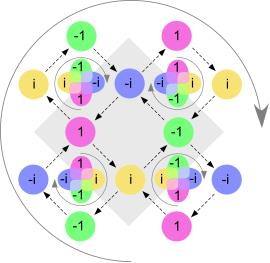Most many-body quantum states in nature may be categorized in terms of broken symmetries. Often it is the translational symmetry that is broken, for example when water crystallizes to form ice. However, nature provides an additional ordering principle for quantum matter: topology. CUI Prof. Andreas Hemmerich (Universität Hamburg) and his colleagues from Utrecht University and the Wilczek quantum center in Hangzhou introduce two new studies on topology, which could help to better understand topology’s role in developing innovative material. The studies are published in Physical Review Letters.
Topology is a branch of mathematics related to geometry. In its application to condensed matter, the global geometric properties of quantum fields are being analyzed, which determine the properties of matter. The basic principle is also known in our classical world. Bodies, which can be deformed into each other continuously, are called topologically equivalent – like for example a ball and a cube or a ring and a cup with a handle. On the other hand, a ball cannot be deformed continuously into a ring. At some point the hole, that makes the ring a ring, has to open up. This opening is an abrupt transition comparable to the transition of water to ice.
Topological materials, although insulating in the bulk, may carry quantized charge or spin currents at the edges. To study topological excitations, the scientists use ultracold atoms in optical lattices. “The use of bosonic atoms loaded into an optical lattice opens up an entirely new world of possible topological quantum systems not realized in electronic condensed matter,” says Hemmerich.

Sketch of the emerging ground state wave function with its unit cell marked by the grey rectangle. The colored p- and s-orbitals are arranged on a face-centered square lattice with the local phases (1, i,-i,-1) illustrated by different colors. Due to contact interaction in the p-orbitals, rectified vortical plaquette currents and orbital currents arise.
The scientists now propose two optical lattice scenarios with bosonic atoms, in which the system with a single atom does not show topological properties. “In combination with many interacting atoms, however, intriguing new states of matter are developing,” says Hemmrich. On top of non-topological chiral ground states showing interaction-driven vortical currents, chiral topological excitations develop on the surface. Hemmerich: “In the long run, basic research in topological quantum systems can help in driving the development of new quantum technology such as quantum computers.”
Citations:
Di Liberto M., Hemmerich A., and Morais Smith C.
Topological Varma superfluid in optical lattices
Physical Review Letters, accepted (2016)
DOI: 10.1103/PhysRevLett.117.163001
Xu Z.-F., You L., Hemmerich A., Liu W. V.
Π-flux Dirac bosons and topological edge excitations in a bosonic chiral p-wave superfluid
Physical Review Letters 117, 085301 (2016)
DOI: 10.1103/PhysRevLett.117.085301

